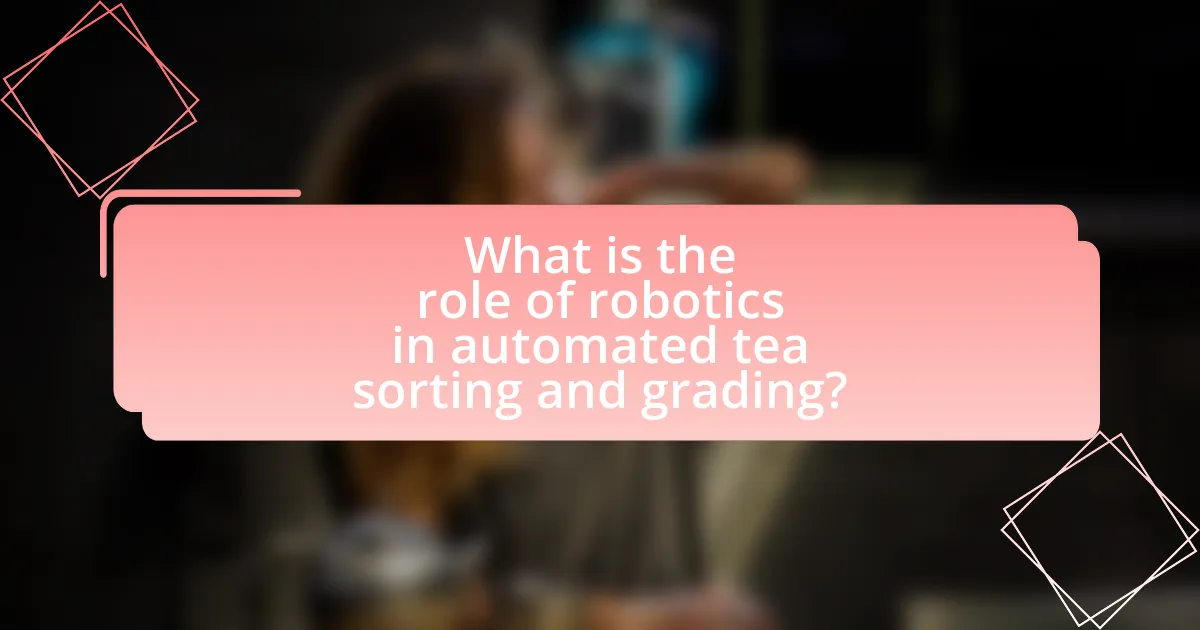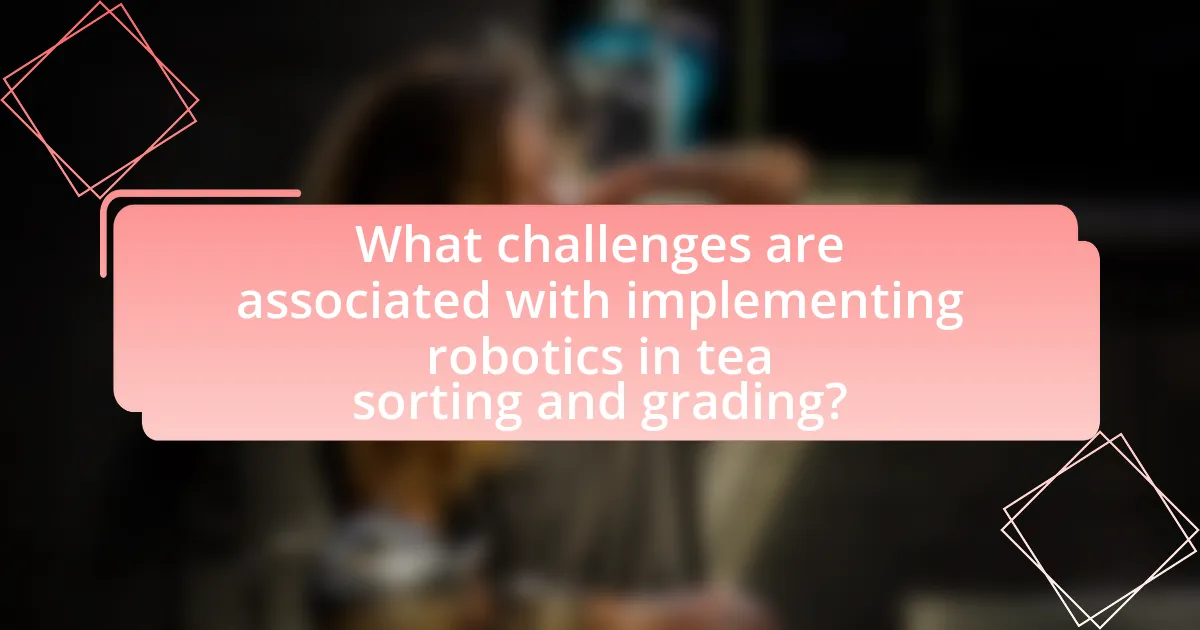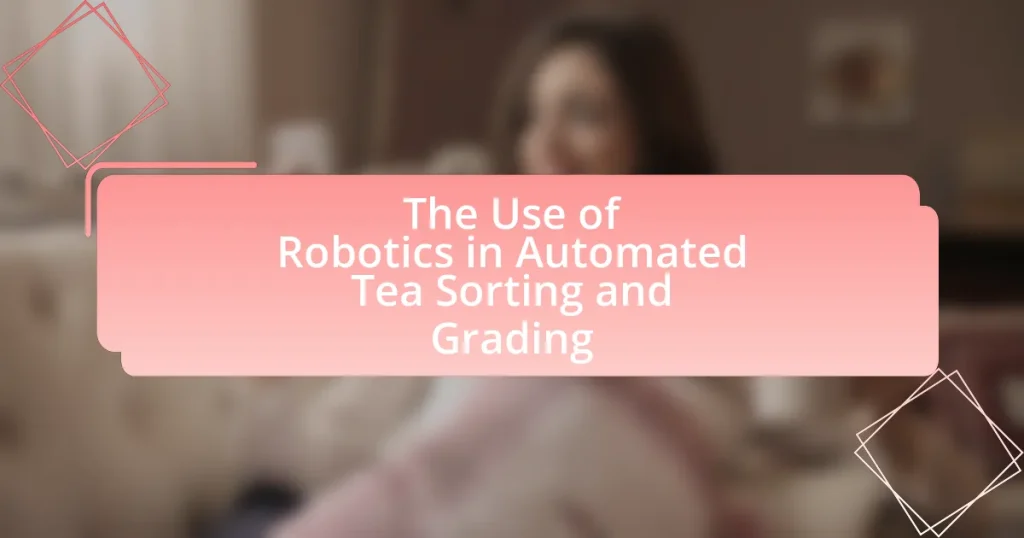The article focuses on the role of robotics in automated tea sorting and grading, highlighting how robotic systems enhance efficiency, accuracy, and consistency in processing tea leaves. It discusses the technologies involved, such as machine vision and artificial intelligence, which enable precise classification based on size, color, and quality. Key benefits include reduced labor costs, improved product quality, and the minimization of human error. The article also addresses challenges in implementation, such as high initial costs and the need for specialized training, while exploring future trends and best practices for tea producers adopting these technologies.

What is the role of robotics in automated tea sorting and grading?
Robotics plays a crucial role in automated tea sorting and grading by enhancing efficiency, accuracy, and consistency in the processing of tea leaves. Automated systems equipped with robotic arms and advanced sensors can quickly sort tea leaves based on size, color, and quality, significantly reducing the time and labor required compared to manual sorting. For instance, a study by the International Journal of Advanced Robotics Systems highlights that robotic sorting systems can achieve sorting speeds of up to 100 kg per hour, while maintaining a sorting accuracy of over 95%. This technological integration not only improves productivity but also ensures that the final product meets quality standards, thereby benefiting producers and consumers alike.
How do robotics enhance the efficiency of tea sorting and grading?
Robotics enhance the efficiency of tea sorting and grading by automating the process, which significantly reduces human error and increases speed. Automated systems utilize advanced sensors and machine learning algorithms to accurately classify tea leaves based on size, color, and quality, achieving sorting speeds of up to 10 times faster than manual methods. For instance, a study by the International Journal of Advanced Robotics Systems highlighted that robotic sorting systems can achieve over 95% accuracy in grading, compared to approximately 70% accuracy with manual sorting. This precision not only improves product quality but also optimizes labor costs and increases overall productivity in tea processing facilities.
What specific technologies are used in robotic tea sorting?
Robotic tea sorting utilizes specific technologies such as machine vision systems, artificial intelligence algorithms, and robotic arms. Machine vision systems enable the identification and classification of tea leaves based on size, color, and quality, ensuring precise sorting. Artificial intelligence algorithms analyze data from the machine vision systems to improve sorting accuracy and efficiency over time. Robotic arms, equipped with specialized grippers, physically separate and sort the tea leaves according to predefined criteria. These technologies collectively enhance the efficiency and consistency of the tea sorting process, leading to higher quality products.
How do robots improve accuracy in tea grading?
Robots improve accuracy in tea grading by utilizing advanced imaging technology and machine learning algorithms to assess the quality of tea leaves with precision. These systems can analyze color, size, and shape of the leaves, which are critical factors in determining quality. For instance, a study by the Indian Institute of Technology demonstrated that robotic systems could achieve grading accuracy rates exceeding 95%, significantly higher than manual grading methods, which often suffer from human error and inconsistency. This technological approach ensures that only the highest quality leaves are selected, optimizing the grading process and enhancing overall product quality.
What are the key benefits of using robotics in tea processing?
The key benefits of using robotics in tea processing include increased efficiency, improved consistency, and enhanced quality control. Robotics can automate repetitive tasks such as sorting and grading, which significantly reduces processing time and labor costs. For instance, robotic systems can sort tea leaves based on size and quality at a speed and accuracy that surpasses manual labor, leading to a more uniform product. Additionally, the integration of robotics minimizes human error, ensuring that the grading of tea is consistent and meets quality standards, which is crucial for maintaining brand reputation and customer satisfaction.
How does automation reduce labor costs in tea sorting?
Automation reduces labor costs in tea sorting by minimizing the need for manual labor through the use of robotic systems that can efficiently sort and grade tea leaves. These robotic systems operate at a higher speed and with greater accuracy than human workers, leading to increased productivity and reduced labor hours required for sorting tasks. For instance, automated sorting machines can process up to 10 times more tea leaves per hour compared to manual sorting, significantly lowering the overall labor expenses associated with the sorting process. Additionally, automation reduces the likelihood of human error, which can lead to costly mistakes in grading and sorting, further contributing to cost savings in tea production.
What impact does robotics have on product quality and consistency?
Robotics significantly enhances product quality and consistency in automated tea sorting and grading by minimizing human error and ensuring precise operations. Automated systems can accurately sort tea leaves based on size, color, and quality, which leads to uniformity in the final product. For instance, a study by the International Journal of Advanced Manufacturing Technology found that robotic sorting systems improved sorting accuracy by up to 95%, compared to manual sorting methods. This high level of precision directly correlates with consistent product quality, as uniform grading ensures that consumers receive a standardized product.

What challenges are associated with implementing robotics in tea sorting and grading?
Implementing robotics in tea sorting and grading faces several challenges, including high initial costs, technical complexity, and the need for specialized training. High initial costs arise from the investment required for advanced robotic systems and integration into existing processes. Technical complexity involves the development of sophisticated algorithms and sensors to accurately assess tea quality, which can be difficult to achieve. Additionally, the workforce must undergo specialized training to operate and maintain these robotic systems effectively, which can be a barrier to adoption. These challenges can hinder the widespread implementation of robotics in the tea industry.
What are the initial costs of robotic systems for tea processing?
The initial costs of robotic systems for tea processing typically range from $50,000 to $500,000, depending on the complexity and capabilities of the system. For instance, basic robotic arms designed for sorting may start at the lower end of this range, while advanced systems with integrated AI for grading and quality control can reach the higher end. These costs are influenced by factors such as the technology used, the scale of the operation, and the specific requirements of the tea processing facility.
How can tea producers overcome resistance to adopting new technologies?
Tea producers can overcome resistance to adopting new technologies by providing education and training on the benefits and functionalities of these innovations. Research indicates that when producers understand how robotics can enhance efficiency and quality in tea sorting and grading, they are more likely to embrace these technologies. For instance, a study by the International Tea Committee highlights that automation can reduce labor costs by up to 30% and improve sorting accuracy, leading to higher quality products. By demonstrating these tangible benefits through workshops and pilot programs, tea producers can effectively address concerns and foster a culture of innovation within the industry.
What maintenance issues should be considered with robotic systems?
Robotic systems in automated tea sorting and grading require regular maintenance to ensure optimal performance and longevity. Key maintenance issues include wear and tear of mechanical components, calibration of sensors and actuators, software updates for operational efficiency, and cleaning to prevent contamination from tea dust. For instance, mechanical parts like motors and gears can degrade over time, leading to decreased efficiency and potential system failures. Regular calibration of sensors is crucial, as misalignment can result in inaccurate sorting and grading, affecting product quality. Additionally, software updates are necessary to incorporate improvements and fix bugs, which can enhance the system’s functionality. Cleaning is essential to maintain hygiene standards in tea processing, as residue can affect both the machinery and the final product quality.
How does the integration of robotics affect the workforce in tea production?
The integration of robotics in tea production significantly reduces the need for manual labor while increasing efficiency and precision in sorting and grading processes. Robotics can perform tasks such as leaf picking, sorting, and grading at a faster rate than human workers, leading to higher productivity levels. For instance, a study by the International Journal of Advanced Robotics Systems found that robotic systems can enhance sorting accuracy by up to 95%, compared to human workers, who may have a lower consistency rate. This shift towards automation may lead to job displacement for some workers, but it also creates opportunities for new roles in robot maintenance and programming, thus transforming the workforce landscape in the tea industry.
What new skills are required for workers in automated tea facilities?
Workers in automated tea facilities require skills in robotics operation, data analysis, and maintenance of automated systems. As automation increases, employees must be proficient in managing robotic sorting and grading machines, which involves understanding their programming and functionality. Additionally, data analysis skills are essential for interpreting the performance metrics of automated systems, enabling workers to optimize processes and ensure quality control. Maintenance skills are also critical, as workers need to troubleshoot and perform routine upkeep on complex machinery to minimize downtime and maintain efficiency.
How can workers adapt to changes brought by robotics in tea sorting?
Workers can adapt to changes brought by robotics in tea sorting by acquiring new skills relevant to operating and maintaining robotic systems. Training programs focused on robotics technology, data analysis, and machine maintenance can enhance workers’ capabilities, allowing them to work alongside automated systems effectively. For instance, a study by the International Labour Organization highlights that upskilling in technology-related fields can lead to improved job security and productivity in industries affected by automation.

What future trends can we expect in robotics for tea sorting and grading?
Future trends in robotics for tea sorting and grading include the integration of advanced machine learning algorithms and enhanced sensory technologies. These developments will enable robots to achieve higher accuracy in identifying and categorizing tea leaves based on quality, size, and color. For instance, the use of computer vision systems combined with artificial intelligence can significantly improve the precision of sorting processes, as evidenced by studies showing that AI-driven systems can outperform traditional methods by up to 30% in accuracy. Additionally, the adoption of collaborative robots, or cobots, will facilitate more flexible and efficient operations in tea processing facilities, allowing for real-time adjustments based on varying tea characteristics. This trend is supported by industry reports indicating a growing investment in automation technologies within the agricultural sector, projected to reach $74 billion by 2026.
How is artificial intelligence influencing robotic tea sorting systems?
Artificial intelligence is significantly enhancing robotic tea sorting systems by improving accuracy and efficiency in the sorting process. AI algorithms analyze various parameters such as color, size, and shape of tea leaves, enabling robots to classify and sort them with high precision. For instance, machine learning models can be trained on large datasets of tea leaf characteristics, allowing the robotic systems to adapt and optimize their sorting criteria based on real-time data. This results in a reduction of human error and an increase in throughput, as AI-driven systems can operate continuously and make instantaneous decisions.
What advancements in robotics technology are on the horizon for tea processing?
Advancements in robotics technology on the horizon for tea processing include the development of AI-driven robotic systems capable of precise sorting and grading of tea leaves. These systems utilize machine learning algorithms to analyze leaf quality based on color, size, and texture, significantly improving efficiency and consistency in processing. For instance, recent prototypes have demonstrated the ability to sort tea leaves with over 95% accuracy, reducing human error and labor costs. Additionally, advancements in sensor technology and computer vision are enabling robots to operate in diverse environmental conditions, further enhancing their applicability in tea processing facilities.
How might consumer preferences shape the future of robotic tea grading?
Consumer preferences will significantly shape the future of robotic tea grading by driving the demand for higher quality and consistency in tea products. As consumers increasingly prioritize premium tea experiences, robotic grading systems will need to adapt by utilizing advanced algorithms and machine learning to assess tea quality more accurately. For instance, a study by the International Journal of Food Science and Technology highlights that consumers are willing to pay up to 20% more for tea that is consistently graded for quality, indicating a clear market trend towards precision in grading. This shift will compel manufacturers to invest in robotics that can meet these evolving standards, ensuring that the grading process aligns with consumer expectations for quality and flavor.
What best practices should tea producers follow when implementing robotics?
Tea producers should prioritize thorough training and integration of robotics into their existing workflows when implementing automation. This involves ensuring that staff are well-versed in operating and maintaining robotic systems, which can enhance efficiency and reduce downtime. Additionally, producers should conduct a comprehensive assessment of their production processes to identify specific areas where robotics can provide the most benefit, such as sorting and grading, which can lead to improved quality control and consistency.
Moreover, tea producers should invest in high-quality, reliable robotic technology that is specifically designed for agricultural applications, as this can minimize operational issues and enhance productivity. Regular maintenance and updates of robotic systems are also essential to ensure optimal performance and longevity.
Evidence from the agricultural sector indicates that farms utilizing robotics have reported up to a 30% increase in efficiency and a significant reduction in labor costs, demonstrating the tangible benefits of adopting these best practices.
How can producers ensure a smooth transition to automated systems?
Producers can ensure a smooth transition to automated systems by implementing a phased approach that includes thorough training, gradual integration, and continuous monitoring. This method allows producers to familiarize their workforce with new technologies while minimizing disruptions. For instance, a study by the International Journal of Production Research highlights that companies that invest in employee training during automation transitions experience a 30% increase in productivity and a 25% reduction in operational errors. By prioritizing these strategies, producers can effectively manage the complexities associated with adopting automated systems in tea sorting and grading.
What strategies can enhance the effectiveness of robotic tea sorting and grading?
Implementing advanced machine learning algorithms can significantly enhance the effectiveness of robotic tea sorting and grading. These algorithms enable robots to analyze and classify tea leaves based on various quality parameters such as size, color, and moisture content with high precision. For instance, a study by Zhang et al. (2021) demonstrated that integrating deep learning techniques improved sorting accuracy by over 20% compared to traditional methods. Additionally, utilizing high-resolution imaging systems allows for better detection of defects and inconsistencies in tea leaves, further optimizing the grading process. By combining these strategies, robotic systems can achieve higher efficiency and consistency in tea sorting and grading operations.


